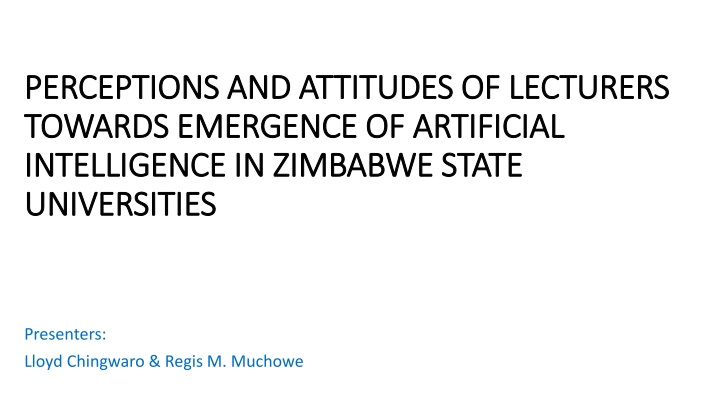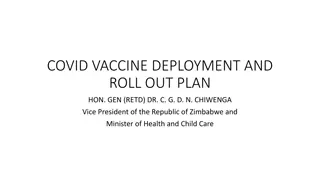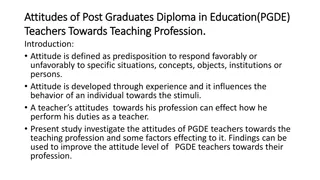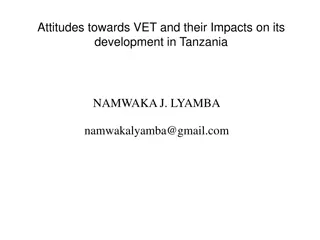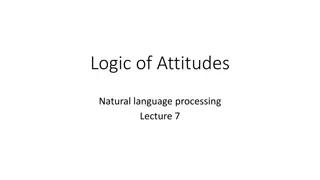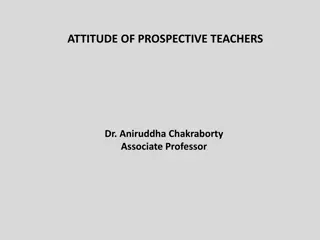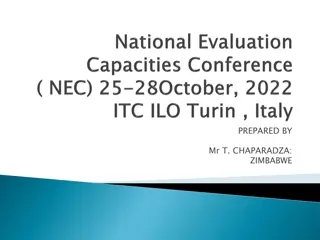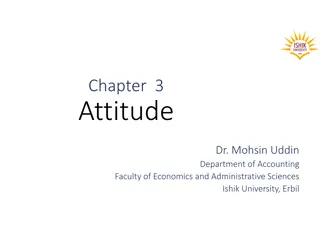Perceptions and Attitudes of Lecturers Towards Emergence of AI in Zimbabwe State Universities
The study delves into lecturers' perceptions and attitudes regarding the integration of Artificial Intelligence in Zimbabwe State Universities. It examines AI's impact on teaching, learning processes, and assessment mechanisms while also exploring the level of AI awareness among lecturers. The research aims to shed light on the evolving role of technology in the education sector.
Uploaded on Mar 15, 2025 | 1 Views
Download Presentation

Please find below an Image/Link to download the presentation.
The content on the website is provided AS IS for your information and personal use only. It may not be sold, licensed, or shared on other websites without obtaining consent from the author.If you encounter any issues during the download, it is possible that the publisher has removed the file from their server.
You are allowed to download the files provided on this website for personal or commercial use, subject to the condition that they are used lawfully. All files are the property of their respective owners.
The content on the website is provided AS IS for your information and personal use only. It may not be sold, licensed, or shared on other websites without obtaining consent from the author.
E N D
Presentation Transcript
PERCEPTIONS AND ATTITUDES OF LECTURERS PERCEPTIONS AND ATTITUDES OF LECTURERS TOWARDS EMERGENCE OF ARTIFICIAL TOWARDS EMERGENCE OF ARTIFICIAL INTELLIGENCE IN ZIMBABWE STATE INTELLIGENCE IN ZIMBABWE STATE UNIVERSITIES UNIVERSITIES Presenters: Lloyd Chingwaro & Regis M. Muchowe
INTRODUCTION INTRODUCTION The study aims to understand lecturers perceptions and attitudes towards the emergence of Artificial Intelligence (AI) in Zimbabwe State Universities. Studies and technological trends show that AI is transforming and revolutionizing various sectors worldwide and the education sector is not an exception. Teaching and learning processes are likely to be transformed. Lecturers are at the centre of the teaching and learning process, hence successful integration of AI tools in the teaching and learning process requires understanding their perceptions and attitudes.
INTRODUCTION(CONT) INTRODUCTION (CONT) Through use of chatbots such as ChatGPT, Notion, Bard, Bing etc., students can now easily find answers and get their assignments done on their behalf by AI. Lecturers can also use AI to customize some tasks such as repetitive administrative work, assignment grading, setting assignments, tests and exams. Some researchers such as (Huang, et al., 2021) are worried with issues of fairness and ethics on AI adoption. In Africa, AI adoption is increasing gradually and some universities are setting up institutes and centers on AI and emerging technologies as shown below:
OBJECTIVES OBJECTIVES 1. To assess the level of understanding and awareness of artificial intelligence (AI) use among lecturers in the context of teaching and learning in Zimbabwe state universities. 2. To examine lecturers attitudes and perceptions towards potential impact of AI on the teaching and learning process in Zimbabwe state universities. 3. To identify mechanisms used to ensure effective assessment in light of artificial intelligence in Zimbabwe state universities.
LITERATURE REVIEW LITERATURE REVIEW AI involves the study of agents that perform actions on the percepts received from the environment (Russell & Norvig, 2016). On the other hand Nilsson (2010) defined AI as an activity that involves creating machines with the capability to perform tasks that normally require human intelligence. Technology Acceptance Model (TAM) developed by Davis (1989) Innovation Diffusion Theory (IDT) (Rogers ,1962; 1995)
LITERATURE REVIEW(CONT) LITERATURE REVIEW (CONT) Analysis carried out in 2021 show that 67% of higher education institutions in Africa have AI researchers or experts and 54% at least have courses related to AI Transformation, 2023). Courses on offer were in the area of Computer Science, Information Technology and Statistical Modelling. Lecturers perceptions and attitudes towards emergence of AI are varied because of factors such as technological competency, training and support, institutional culture and policies, and perceived benefits and risks (Hodges & Ocak, 2023; Abdous, 2023; Schiller International University, 2023) (African Center for Economic
LITERATURE REVIEW(CONT) LITERATURE REVIEW (CONT) For students and lecturers to truly gain an understanding of AI systems they need to be trained on how to use these AI tools responsibly to their advantage (Stachowicz-Stanusch & Amann, 2018) A 2016 report by Stanford University reveals that learning institutions have been adopting AI technologies at a slower rate due to lack of funding and lack of empirical evidence that these AI tools actually help students achieve learning objectives. Bali, et al (2022) find that adopting AI technologies in universities bring with it both positive and negative impact on the learning outcomes for students, for example when AI is used in non-traditional settings it positively affected emotional quotient, spiritual quotient and intelligent quotient.
METHODOLOGY METHODOLOGY Qualitative methodologies were adopted. Target population was lecturers from state universities in Zimbabwe. Face to face and telephone interviews were conducted. Data saturation was reached after the 12thinterview, indicating that further interviews would not provide significant new insights therefore to save on resources the interviews were stopped. To establish data trustworthiness, the interviews were conducted twice after one month interval. Thematic analysis was adopted for data analysis.
RESULTS RESULTS Objective 1: Level of understanding and awareness of artificial intelligence (AI) Younger lecturers demonstrated a higher understanding of artificial intelligence compared to older lecturers. Lecturers in computer science departments showed greater knowledge of artificial intelligence.
RESULTS(CONT) RESULTS (CONT) Objective 2: Lecturers attitudes and perceptions towards potential impact of AI on the teaching and learning process. Theme 1: Plagiarism Serious concern among lecturers due to students using AI, such as chatgpt, to write their assignments and engage in plagiarism. Theme 2: Lack of Research Skills Students no longer engage in comprehensive research as they rely on AI chatbots for assignment completion. Theme 3: Half-Backed Graduates Concern that AI reliance will lead to graduates lacking problem-solving skills and being ill-prepared for the workforce. Theme 4: AI as a Source of Information Lecturers perceive AI as a valuable source of information for research purposes.
RESULTS(CONT) RESULTS (CONT) Objective 3: Mechanisms used to ensure effective assessment in light of emergence of artificial intelligence Mechanism 1: In-Class Tests Some lecturers in state universities are beginning to utilize in-class tests to assess students' understanding of key concepts. Mechanism 2: Class Presentations Lecturers replace assignments with class presentations to mitigate AI reliance. Mechanism 3: Reducing Coursework Assignment Percentage Lecturers decrease the contribution of assignments to overall coursework grades. Mechanism 4: Viva Voce Viva voce, oral examinations, used to assess research projects and verify student involvement.
CONCLUSIONS AND RECOMMENDATIONS CONCLUSIONS AND RECOMMENDATIONS Conclusion 1: Knowledge and Perceptions Young lecturers and those in computer sciences display higher knowledge about artificial intelligence. Study finds negative perceptions among Zimbabwe state university lecturers, as AI contributes to plagiarism, laziness, lack of research skills and production of graduates lacking critical thinking skills. Conclusion 2: Assessment Strategies In-class tests and presentations replace assignments for effective assessment in the presence of AI. Coursework contribution of assignments is lowered, while viva voce is used for research projects.
CONCLUSIONS AND RECOMMENDATIONS(CONT) CONCLUSIONS AND RECOMMENDATIONS (CONT) Recommendation 1: Embrace AI Encourage lecturers to embrace the impact of AI in higher education because AI is here to stay and can enhance teaching and learning processes. Recommendation 2: Anti-Plagiarism Measures Zimbabwe state universities should develop or adopt anti-plagiarism tools capable of detecting AI usage in assignments, this will address the serious offense of plagiarism facilitated by AI.
CONCLUSIONS AND RECOMMENDATIONS(CONT) CONCLUSIONS AND RECOMMENDATIONS (CONT) Recommendation 3: Balanced Assessment Approach Advocate for the use of assignments alongside other face-to-face coursework activities, because maintaining a balanced assessment approach ensures comprehensive evaluation of student learning. Recommendation 4: Focus on Student Perceptions Future studies should explore university students' perceptions of AI integration in their learning experiences. Understanding student perspectives will inform further improvements and adjustments in AI implementation.
REFERENCES REFERENCES Abdous, M., 2023. How AI Is Shaping the Future of Higher Ed. [Online] Available at: https://www.insidehighered.com/views/2023/03/22/how-ai-shaping- future-higher-ed-opinion [Accessed 1 October 2023]. African-Center-for-Economic-Transformation, 2023. Artificial Intelligence for Economic Policy-making: The frontier of Africa's Economic Transformation, Accra: African Center for Economic Transformation. Bali, M. M., Kumalasani, M. P. & Yunilasari, D., 2022. Artificial Intelligence in Higher Education: Perspicacity Relation between Educators and Students.. Journal of Innovation in Educational and Cultural Research, 3(2), pp. 146-152. Davis , D. F., 1989. Perceived usefulness, perceived ease of use, and user acceptance of information technology. Management Information Systems Research Center, University of Minnesota, 13(3), pp. 319-340. Hodges, C. & Ocak, C., 2023. Integrating Generative AI into Higher Education: Considerations. [Online] Available at: https://er.educause.edu/articles/2023/8/integrating-generative-ai-into-higher-education-considerations [Accessed 9 October 2020]. Huang, J., Saleh, S. & Liu, Y., 2021. A Review on Artificial Intelligence in Education. Academic Journal of Interdisciplinary Studies, 10(3), pp. 206-217. Nilsson, N., 2010. The quest for artificial intelligence: A history of ideas and achievements. Cambridge : Cambridge University Press . Rogers , M. E., 1962. Diffusion of Innovations. New York: The Free Press. Rogers , M. E., 1995. Diffusion of Innovations. 4th ed. New York : The Free Press. Russell, J. S. & Norvig, P., 2016. Artificial Intelligence: A Modern Approach. 3rd ed. Malaysia: Artificial Intelligence: A Modern Approach. Schiller-International-University, 2023. The Impact of Artificial Intelligence on Higher Education: How It Is Transforming Learning. [Online] Available at: https://schiller.edu/blog/the-impact-of-artificial-intelligence-on-higher-education-how-it-is-transforming-learning [Accessed 3 November 2023]. Stachowicz-Stanusch, A. & Amann, W., 2018. Artificial intelligence at universities in Poland. Organizacja i Zarz dzanie: kwartalnik naukowy, pp. 63-82. Stanford-University, 2016. Artificial Intelligence and Life in 2030: One Hundred Year Study on Artificial Intelligence, Stanford: Stanford University.
END END
